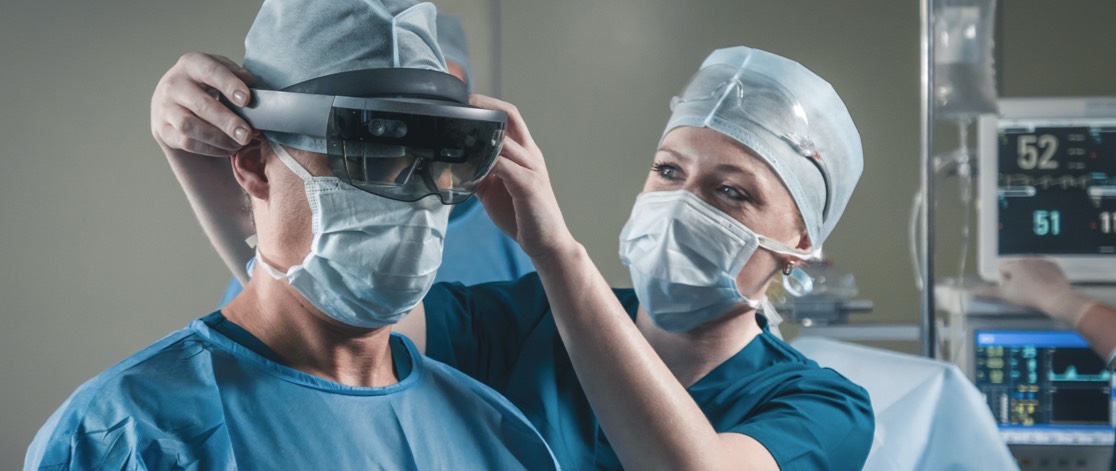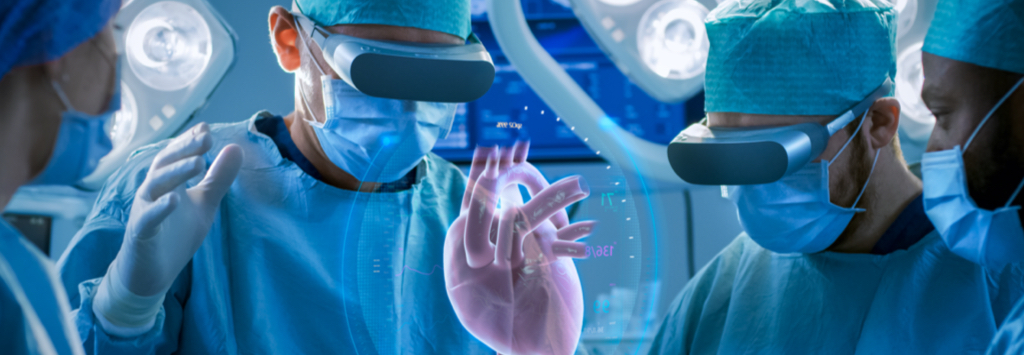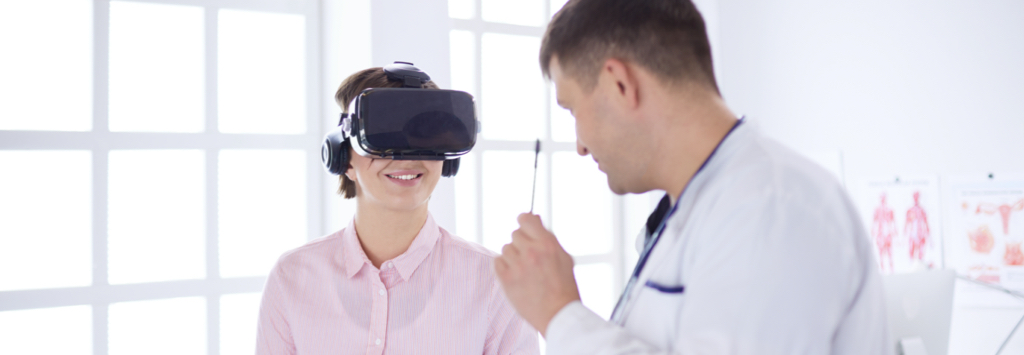INNOVATION
A Positive Prognosis for Augmented Reality in the Healthcare Industry
INNOVATION
A Positive Prognosis for Augmented Reality in the Healthcare Industry


Released in 1966, the movie Fantastic Voyage told the story of a group of scientists who shrunk down to microscopic size so they could venture into the body of an injured scientist to repair damage to his brain. While the special effects would seem more than a little cheesy to a modern audience, at the time, they were considered cutting-edge.
In fact, the film won an Academy Award for Best Visual Effects. While a miniaturized submarine zipping through the bloodstream remains purely science fiction, the deepening role that technology plays in the healthcare industry is not only real but radically changing the entire healthcare experience. One of the leading technologies driving that change is augmented reality.

What Is Augmented Reality?
If you use an app on your phone that allows you to see how a sofa from the furniture store might look in your living room, that’s augmented reality. Those silly filters you use on Snapchat so you suddenly sprout a pair of rabbit ears or have butterflies flitting around your head? That’s also AR. From Uber to GPS, social-media location tagging to Pokemon Go, you’re up to your eyeballs in augmented reality on a daily basis. AR brings the real world and the digital world together.
Clearly, there are many use cases for augmented reality that can positively impact the way we work, learn, and play. However, the area where augmented reality might just be making—and will continue to make the biggest impact—is in the world of healthcare.
The Adoption of AR in Healthcare
Healthcare workers realized the benefits of AR technologies early on, specifically as it relates to education. Obviously, healthcare workers have to learn a vast amount of detailed information about anatomy and the way the body functions. AR applications give learners the ability to visualize and interact with three-dimensional representations of bodies. Beyond education, though, AR’s popularity within healthcare is simply due to the vast number of applications in which it can be leveraged, for example:
A company called SugAR poke designed an app to help eradicate childhood obesity. The app uses object recognition technology combined with AR to help people instantly see the amount of sugar that’s in their favorite foods.
Researchers at the University of Alberta created a system called ProjectDR, which allows medical images such as CT scans and MRI data to be displayed directly on the patient’s body. The system uses spatial computing and motion-tracking using infrared cameras, presenting only the organs that the doctor wants to view.
Clearly, the future of augmented reality in the healthcare field is unlimited. However, today, in hospitals around the world, doctors, nurses, hospitals, and patients themselves are already benefiting from augmented reality in tangible ways.
According to Statista, the total global MedTech industry is approximately worth half a trillion dollars.

Augmented Reality in Practice
While many applications of augmented reality are still in the early stages of development, here are a few real-world examples of augmented reality positively impacting the healthcare industry today:
Education
Medical Students can now undergo the same training experience at the same time, whether they’re in the same location or not—everything from learning how to take a pulse, dissect a cadaver, or view an actual surgery—thereby making the education process more efficient.
Researchers at Johns Hopkins University embarked on an AR project that would display an internal view of the body on top of a student’s physique. The technology also includes a gesture-sensitive user interface, allowing people to interact with the AR representation.
With increased workload and stringent regulatory requirements, seasoned doctors and nurses not only need to stay current with their skills but continue to learn about new treatments and procedures. AR allows them to do that without the inconvenience of having to travel or being away from their patients.
Visualization
Even the most experienced surgeons sometimes encounter surprises when operating on patients, but augmented reality helps make those instances less common. By “practicing” the procedure prior to actual surgery, doctors can be better prepared to deal with any potential complications.
One practical application of AR in use today is vein visualization. Many patients are uncomfortable with being injected or having blood taken, an experience made even worse when it’s difficult to find a vein and the patient has to be “stuck” several times. Vein visualization projects a map of a patient’s veins onto their skin, making it easier for healthcare workers to find the vein the first time.
Patient Confidence & Education
It’s not just healthcare workers who benefit from augmented reality. It’s also useful as a tool to educate patients on planned procedures, which helps to instill confidence in the patient’s mind in terms of their decision to have the procedure, as well as in their surgeon.
Researchers have investigated using AR to educate patients before their surgeries. For example, a person can see a digitized version of their brain, along with the specific problem that the surgeon needs to correct and how they’ll go about doing that.
Hospitals
Augmented reality technologies not only allow hospitals to offer cutting-edge treatments to patients, it also helps the hospital enhance its reputation as an innovative medical institution.
Covered extensively by the media, last year, a thirty-person team of doctors and nurses in California prepared to separate conjoined twins by using mixed reality goggles, providing them with an augmented view of the complex network of blood vessels that would need to be untangled during the surgery.
As anyone who has ever spent some time trying to find their way around a hospital can tell you, they’re not the easiest places to navigate. In fact, around one-third of first-time hospital visitors get lost or confused.
At Cortellucci Vaughn Hospital in Ontario, Canada, the rapid response team wear real-time location badges that override elevator systems to give them priority. Additionally, when the system detects a cardiac arrest, it automatically adjusts the patient’s bed and IV to best assist responders.
We Care About Healthcare
By partnering with hospitals and universities, and showing them how AR technology can be utilized to develop a training curriculum, PeakActivity is able to contribute to the important goal of helping medical professionals provide their patients with the kind of next-level quality of care they need and deserve. Of course, augmented reality can be applied beyond the world of healthcare. PeakActivity also works with clients across a number of other industries in this space, including educational institutions in their efforts to help students, as well as teachers, be more successful in their respective education journeys.

Feeling Better About the Future of Healthcare
With the myriad ways that spatial computing has already altered the healthcare landscape, it’s easy to see that what is yet to come will be nothing short of remarkable. From helping to diagnose and treat patients by enabling greater degrees of collaboration, comfort, and efficiency, to making educating and training future medical professionals even more convenient and effective through the use of augmented reality, the future health of the healthcare industry looks incredibly promising. As for miniaturized submarines cruising around our bodies, well, there’s always the movies.
Want even more educational content?
Subscribe below to get timely content delivered to your inbox,
or fill out the form below to speak to a Peakster about your next project.

DIGITAL MARKETING
Top 10 Photos of Developers Staring At Screens

DIGITAL STRATEGY
5 Ways Retailers Can Make Influencer Marketing More Influential

ECOMMERCE